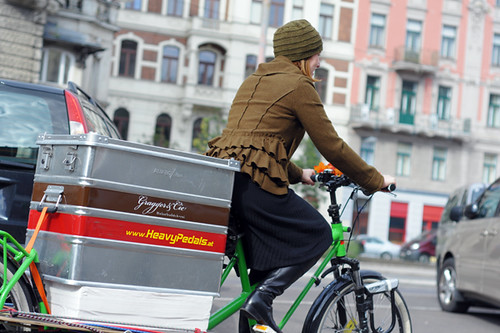 Finally, a cargo bike I can comfortably ride. A proper, enormous, heavy cargo bike. In the past I've described finding this genre of bicycles challenging to handle, and some of you have suggested that I might find a longtail easier than a front-load system. You were right! But this is not your typical longtail.
Finally, a cargo bike I can comfortably ride. A proper, enormous, heavy cargo bike. In the past I've described finding this genre of bicycles challenging to handle, and some of you have suggested that I might find a longtail easier than a front-load system. You were right! But this is not your typical longtail. The idea of the MSC Truck is similar to that of a box bike or "long john," except that the loading platform is in the rear. Designed by my friend Wolfgang Hoefler for his delivery companyHeavy Pedals (in Vienna, Austria), the bike is manufactured by the Viennese Maderna Cycle Systems.
The idea of the MSC Truck is similar to that of a box bike or "long john," except that the loading platform is in the rear. Designed by my friend Wolfgang Hoefler for his delivery companyHeavy Pedals (in Vienna, Austria), the bike is manufactured by the Viennese Maderna Cycle Systems. The mixte-esque frames are made of oversized steel tubing and is manufactured in Europe (Austria and Poland, as far as I understand).
The mixte-esque frames are made of oversized steel tubing and is manufactured in Europe (Austria and Poland, as far as I understand). The bike pictured with the aluminum box is Wolfgang's personal version with various customisations, and above is what the production version looks like with the platform empty. The wheelbase is 200cm and the total length is 265cm. The weight as pictured is 28kg (62lb). The wheels are 26". The rear rack is integrated with the frame, and the rack's tubing will fit many pannier systems including Ortlieb. The bike comes standard with a suspension fork, disk brakes, heavy duty kickstand, plastic fenders, padded vinyl saddle, and straight handlebars. There are several different gearing options, including derailleur and internally geared hub. Dynamo lighting is available as an option as well.
The bike pictured with the aluminum box is Wolfgang's personal version with various customisations, and above is what the production version looks like with the platform empty. The wheelbase is 200cm and the total length is 265cm. The weight as pictured is 28kg (62lb). The wheels are 26". The rear rack is integrated with the frame, and the rack's tubing will fit many pannier systems including Ortlieb. The bike comes standard with a suspension fork, disk brakes, heavy duty kickstand, plastic fenders, padded vinyl saddle, and straight handlebars. There are several different gearing options, including derailleur and internally geared hub. Dynamo lighting is available as an option as well.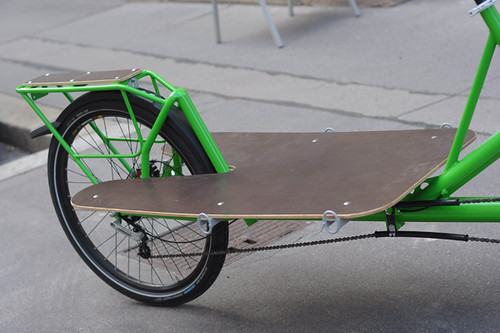 The loading platform is 60cm x 60cm.
The loading platform is 60cm x 60cm.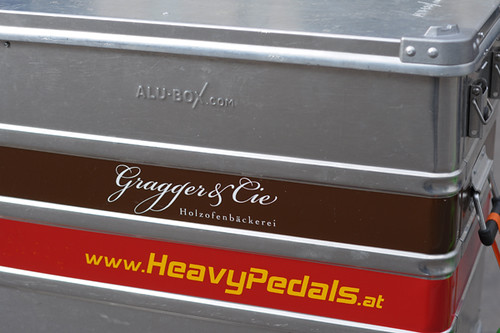 The platform can house a variety of containers. Heavy Pedals prefer to use the customisable Alu-boxes. But it can also be fitted with a more traditional cargo box, or child seats. Personally I would love an option where slatted sides could be added to the platform so that it becomes a container in of itself.
The platform can house a variety of containers. Heavy Pedals prefer to use the customisable Alu-boxes. But it can also be fitted with a more traditional cargo box, or child seats. Personally I would love an option where slatted sides could be added to the platform so that it becomes a container in of itself. There are provisions for bungee cord attachments.
There are provisions for bungee cord attachments.  The front of the bike has a dock to which you could also attach a front rack. Overall the Truck is rated to transport 150kg (331lb) of weight, not counting the cyclist.
The front of the bike has a dock to which you could also attach a front rack. Overall the Truck is rated to transport 150kg (331lb) of weight, not counting the cyclist. 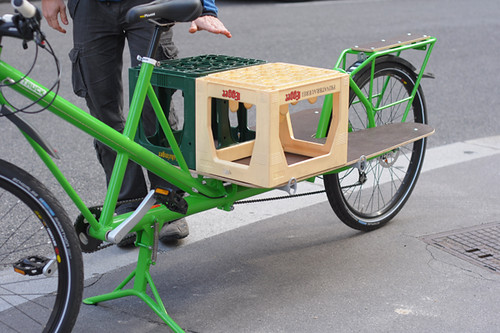 The height of the rack coincides with the height of a typical crate, making it possible to turn the rear into a larger platform still for oversized objects.
The height of the rack coincides with the height of a typical crate, making it possible to turn the rear into a larger platform still for oversized objects.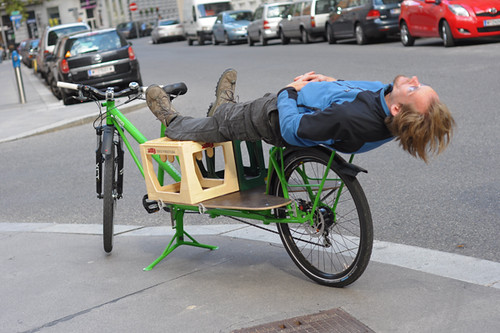 When parked, the bike is very sturdy on its double-legged kickstand; there is no wobble.
When parked, the bike is very sturdy on its double-legged kickstand; there is no wobble.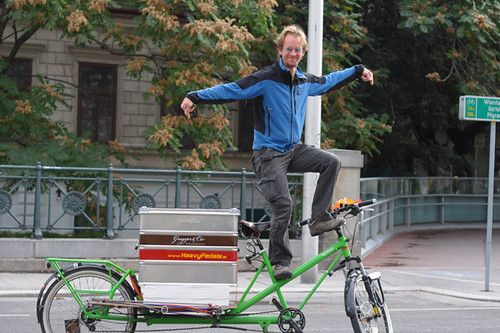 Very sturdy indeed! As I discovered when handling the Truck, there is no need to lift it either to engage or pull up the kickstand - it works via tapping it with your foot and then rolling the bike either forward or back. Even a person of very slight stature can handle it.
Very sturdy indeed! As I discovered when handling the Truck, there is no need to lift it either to engage or pull up the kickstand - it works via tapping it with your foot and then rolling the bike either forward or back. Even a person of very slight stature can handle it. 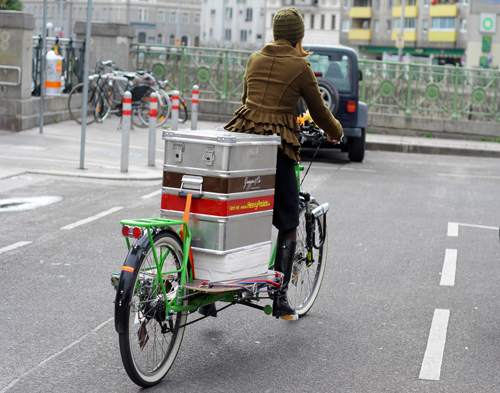 I was reluctant to try riding the Truck, because I did not want to overturn Wolfgang's cargo and chip his paint by crashing it. But he knows my riding style (having taught me to ride a brakeless track bike safely last summer), and assured me I'd be able to ride it. It would feel just like a regular bike, he promised. And there is no dramatic story coming, because it did.Balancing it felt the same as with a regular bike - no twitchiness when starting and braking as I had experienced with front-load bikes. It wasn't especially difficult to maneuver around the very cramped space you see me riding in. I could sense that I had a long tail, but it was intuitive what to do about it. I can't really explain it any better, other than to describe the handling as unremarkable - which, when it comes to cargo bikes, is a compliment. Though I did not ride it through the city, I would feel comfortable trying. According to Wolfgang, the handling is not any different when the platform is empty vs heavily loaded; the only difference is that it's more difficult to go uphill with the extra weight. Typical speed of a moderately loaded Truck is 20 km/h (12.5mph), though it is capable of going over 30 km/h (18.6mph) if the rider prefers to travel faster. The speed depends on the gearing you chose as well.
I was reluctant to try riding the Truck, because I did not want to overturn Wolfgang's cargo and chip his paint by crashing it. But he knows my riding style (having taught me to ride a brakeless track bike safely last summer), and assured me I'd be able to ride it. It would feel just like a regular bike, he promised. And there is no dramatic story coming, because it did.Balancing it felt the same as with a regular bike - no twitchiness when starting and braking as I had experienced with front-load bikes. It wasn't especially difficult to maneuver around the very cramped space you see me riding in. I could sense that I had a long tail, but it was intuitive what to do about it. I can't really explain it any better, other than to describe the handling as unremarkable - which, when it comes to cargo bikes, is a compliment. Though I did not ride it through the city, I would feel comfortable trying. According to Wolfgang, the handling is not any different when the platform is empty vs heavily loaded; the only difference is that it's more difficult to go uphill with the extra weight. Typical speed of a moderately loaded Truck is 20 km/h (12.5mph), though it is capable of going over 30 km/h (18.6mph) if the rider prefers to travel faster. The speed depends on the gearing you chose as well.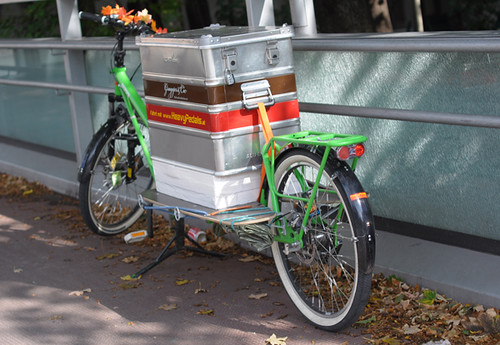 In addition to the fine handling, the Truck was easy to mount and dismount in a skirt thanks to the unisex frame. The adjustable saddle height (via quick-release) was convenient as well. The bike remained stable when I was walking it. A good design all around, it seems to me. It is not as "cute" as a traditional cargo bike and I am not a fan of the colour, but I have no complaints regarding its functionality. In fact, I am wondering what the benefit of a front-loading cargo bike is, if the same weight can be transported via a longtail system without impacting handling - particularly since stuff can be piled higher in the rear, where it will not block the cyclist's field of vision. This is not so much a criticism of front-load bikes, as a genuine question: What accounts for the fact that traditional makers have favoured the front-load system?
In addition to the fine handling, the Truck was easy to mount and dismount in a skirt thanks to the unisex frame. The adjustable saddle height (via quick-release) was convenient as well. The bike remained stable when I was walking it. A good design all around, it seems to me. It is not as "cute" as a traditional cargo bike and I am not a fan of the colour, but I have no complaints regarding its functionality. In fact, I am wondering what the benefit of a front-loading cargo bike is, if the same weight can be transported via a longtail system without impacting handling - particularly since stuff can be piled higher in the rear, where it will not block the cyclist's field of vision. This is not so much a criticism of front-load bikes, as a genuine question: What accounts for the fact that traditional makers have favoured the front-load system? Heavy Pedals is a delivery service and cargo bike shop in one, and they stock all sorts of delivery cycles from different manufacturers - including long johns, bakfietsen and cargo trikes. But the MSC Truck is the one I'd be most comfortable riding on the streets at this stage, given my brief experience with the other styles. Local pricing for the Truck starts at €1999- and there is not currently a North American distributor.
 An honor and an awesome responsibility, they havecatwalks of followers and a good post will push the google servers into the red.
An honor and an awesome responsibility, they havecatwalks of followers and a good post will push the google servers into the red. Who else found themselves getting all inexplicably nervous?A few quick asanas tosooth the jitters.
Who else found themselves getting all inexplicably nervous?A few quick asanas tosooth the jitters.
 There's room on the route for a Rastaman. Liam keeps the vibrations good. Haile man!
There's room on the route for a Rastaman. Liam keeps the vibrations good. Haile man! Climbing was not compulsory on the night. Elise came along to keep the vibe up.
Climbing was not compulsory on the night. Elise came along to keep the vibe up. The dynamic Team Cujes in "Boulders and Nuts" gear from upskillclimbinggear.comLee and Sam Cujes have recently launched their slick newonline store with some fresh ideas about hardware and clothing. I still can't believe how cheap those Climbtech ascenders are!And the girls tell me the Boulders and Nuts halters are excellent quality.
The dynamic Team Cujes in "Boulders and Nuts" gear from upskillclimbinggear.comLee and Sam Cujes have recently launched their slick newonline store with some fresh ideas about hardware and clothing. I still can't believe how cheap those Climbtech ascenders are!And the girls tell me the Boulders and Nuts halters are excellent quality.



 Nate, my preciousblogstar, you know you are just here to push up my blog stats. Even the super styled
Nate, my preciousblogstar, you know you are just here to push up my blog stats. Even the super styled  Before I started cycling I was a vegetarian/ pescetarian for many years. It began by accident: I was on a research trip in Moscow in 1999 and got food poisoning after eating a meat dish at a restaurant. It was pretty bad, though to be fair I can't even be sure it was due to the meat. Could have been the salad or an unwashed fork, who knows. Still, for a whileafterwardI felt sick whenever I looked at or smelled meat, so I stopped eating it. Eventually the effect wore off, but the vegetarian habit remained. I did not crave meat products, and I felt healthier not eating them. Attempts to coax me back into carnivorism were unsuccessful. I could watch others eat meat and even cook meat for guests without being tempted in the least. I was pretty sure this was a permanent lifestyle change.
Before I started cycling I was a vegetarian/ pescetarian for many years. It began by accident: I was on a research trip in Moscow in 1999 and got food poisoning after eating a meat dish at a restaurant. It was pretty bad, though to be fair I can't even be sure it was due to the meat. Could have been the salad or an unwashed fork, who knows. Still, for a whileafterwardI felt sick whenever I looked at or smelled meat, so I stopped eating it. Eventually the effect wore off, but the vegetarian habit remained. I did not crave meat products, and I felt healthier not eating them. Attempts to coax me back into carnivorism were unsuccessful. I could watch others eat meat and even cook meat for guests without being tempted in the least. I was pretty sure this was a permanent lifestyle change. Ahhhh...we are back "home". Or at least our "winter home". We are so happy to be here!
Ahhhh...we are back "home". Or at least our "winter home". We are so happy to be here!
 With the Renaissance of the Mixte still going strong this year, I find myself in frequent discussions over its benefits and drawbacks. And inevitably, I catch myself over-stressing the drawbacks - but it's only because I want to make sure that those who dream of mixtes look at them realistically and not through rose-coloured glasses. There's this idea that the mixte is the perfect do-everything bike, because it can be used both as a roadbike and as a city bike - but I do not entirely agree. So here are some "myths" about the mixte, which I would like to supplement with a more realistic set of expectations:
With the Renaissance of the Mixte still going strong this year, I find myself in frequent discussions over its benefits and drawbacks. And inevitably, I catch myself over-stressing the drawbacks - but it's only because I want to make sure that those who dream of mixtes look at them realistically and not through rose-coloured glasses. There's this idea that the mixte is the perfect do-everything bike, because it can be used both as a roadbike and as a city bike - but I do not entirely agree. So here are some "myths" about the mixte, which I would like to supplement with a more realistic set of expectations: 2. The mixte is easy to mount and dismount
2. The mixte is easy to mount and dismount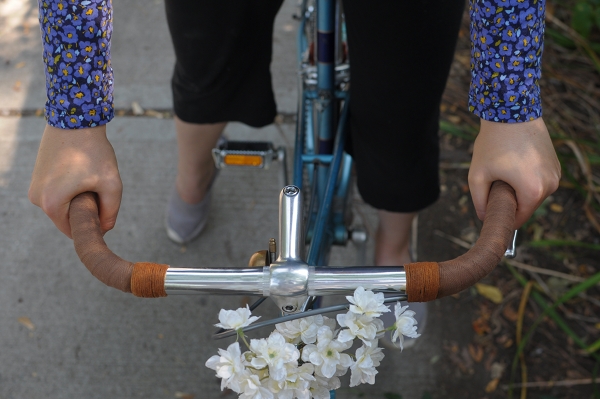 3. The Mixte is Comfortable
3. The Mixte is Comfortable I hope that all of this does not come across as overly negative. Having gotten one custom made, I am obviously a fan of mixtes. But I do think that it helps to have a realistic understanding of what sort of bicycle a mixte is - which includes not only knowing its benefits, but also its limitations. If you are a mixte owner, what make and model do you ride? how have you set it up? do you use it for transportation or recreationally? and what benefits and drawbacks would you say it has?
I hope that all of this does not come across as overly negative. Having gotten one custom made, I am obviously a fan of mixtes. But I do think that it helps to have a realistic understanding of what sort of bicycle a mixte is - which includes not only knowing its benefits, but also its limitations. If you are a mixte owner, what make and model do you ride? how have you set it up? do you use it for transportation or recreationally? and what benefits and drawbacks would you say it has?









 Walking home yesterday afternoon, I was amused to notice how much I tend to do this even when it comes to bicycles.
Walking home yesterday afternoon, I was amused to notice how much I tend to do this even when it comes to bicycles.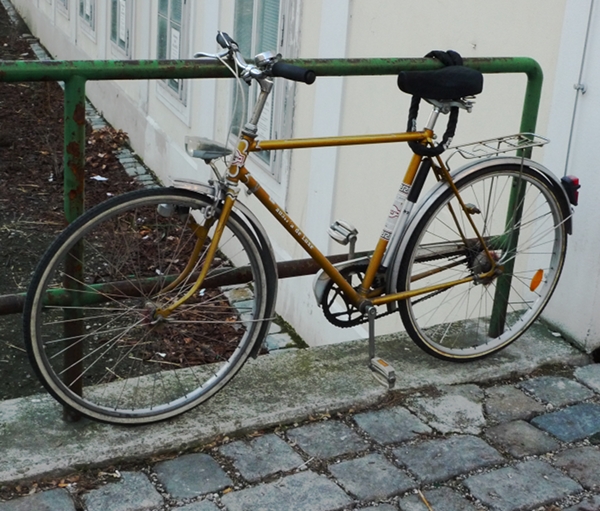 Both Vienna and Boston are full of generic modern unremarkable bikes, yet the ones I pay attention to are the classic and vintage bikes.
Both Vienna and Boston are full of generic modern unremarkable bikes, yet the ones I pay attention to are the classic and vintage bikes. And since I notice these more, in my subsequent memories they are the ones that play a starring role in the city's "velo life".
And since I notice these more, in my subsequent memories they are the ones that play a starring role in the city's "velo life". In a similar fashion, I tend to pay lots of attention to architecture I like and ignore all the "ugly" stuff right next to it. As a result, a city or a neighborhood might consist entirely of beautiful architecture in my memories.
In a similar fashion, I tend to pay lots of attention to architecture I like and ignore all the "ugly" stuff right next to it. As a result, a city or a neighborhood might consist entirely of beautiful architecture in my memories. There are countless examples of this of course, and unless we point and shoot in a random direction we cannot take a picture without revealing our subjective biases. Our pictures reflect how we want to see and remember things rather than how they actually are. For example, several readers have pointed out to me that my "street scenes" tend to be miraculously free of cars, and indeed I seem to frame photos so as to avoid them. There is just something about modern cars that is not photogenic: they detract from the feel of the city landscape.
There are countless examples of this of course, and unless we point and shoot in a random direction we cannot take a picture without revealing our subjective biases. Our pictures reflect how we want to see and remember things rather than how they actually are. For example, several readers have pointed out to me that my "street scenes" tend to be miraculously free of cars, and indeed I seem to frame photos so as to avoid them. There is just something about modern cars that is not photogenic: they detract from the feel of the city landscape.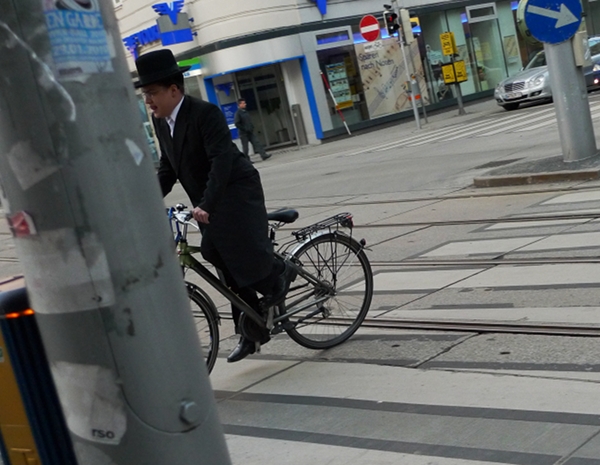 Bicycles, on the other hand, seem to enrich it - especially when the bicycles are nice and the cyclists are well dressed. Yes, that is a Hassidic Jew cycling through Vienna - who clearly has no problem cycling in a suit.
Bicycles, on the other hand, seem to enrich it - especially when the bicycles are nice and the cyclists are well dressed. Yes, that is a Hassidic Jew cycling through Vienna - who clearly has no problem cycling in a suit. And here is a couple, cycling into the sunset idyllically. While of course I did not stage these scenes, you could say that I chose to notice them out of the many alternative scenes I could have noticed instead.
And here is a couple, cycling into the sunset idyllically. While of course I did not stage these scenes, you could say that I chose to notice them out of the many alternative scenes I could have noticed instead.
 We thought it was cute when our cat showed an interest in the Pashley Roadster. But that was nothing compared to her reaction to the vintage Raleigh!
We thought it was cute when our cat showed an interest in the Pashley Roadster. But that was nothing compared to her reaction to the vintage Raleigh! So apparently my cat loves bicycles! -- or at least quality English bicycles? -- We will need to conduct some research to determine the extent of her attraction.
So apparently my cat loves bicycles! -- or at least quality English bicycles? -- We will need to conduct some research to determine the extent of her attraction.